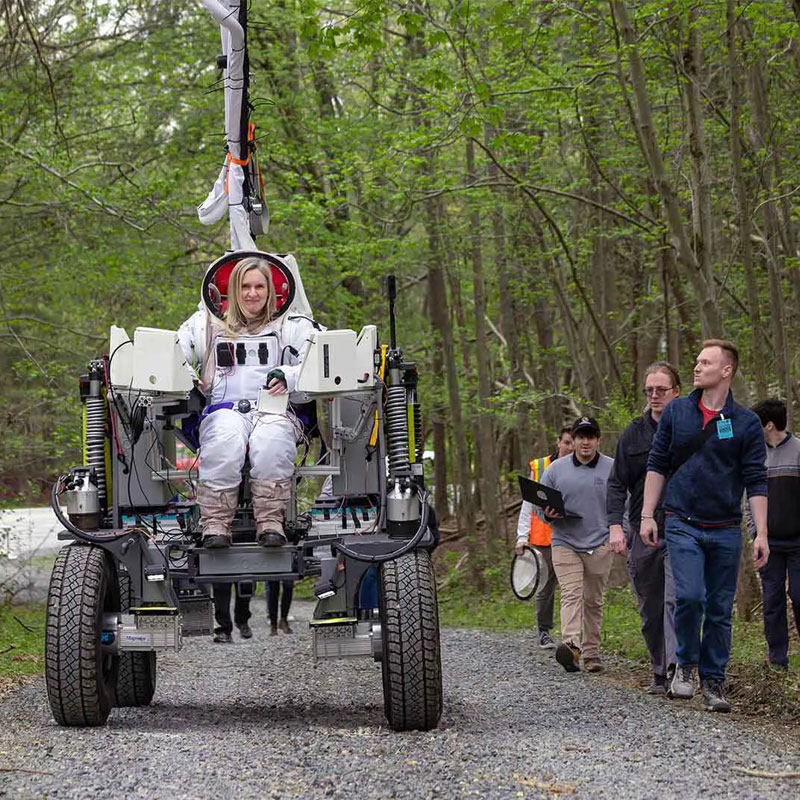Roving Reporter
A nearsighted writer isn’t the logical choice to take the wheel of a half-million-dollar lunar rover prototype funded by the agency that gave us “one giant leap for mankind.” But on a gravel track at nearby NASA Goddard Space Flight Center one spring afternoon, four UMD engineering students and one veteran faculty member wrestled me into a 75-pound space suit to give me a (hopefully non-) crash course on driving the one-seat all-terrain vehicle they had dedicated three years to building—not to drive publicity, but to steer closer to perfection. “We are constantly working, constantly trying to improve it,” says doctoral candidate Charlie Hanner, one of the project leads. “Hopefully we can contribute something that’s never been done before.” Developed under NASA’s Innovative Advanced Concepts program, which funds visionary ideas that could shape the future of space exploration, the prototype could help inspire the finished product: a vehicle for astronauts to one day navigate the surface of the moon through the Artemis mission as they build a base to slingshot human explorers to Mars. But first, astronauts must contend with unforgiving lunar conditions. The rugged terrain is covered in a fine, microscopically jagged dust that sticks to everything, clogs mechanisms and is like propelling through fine flour. In full sun, temperatures on the moon’s surface can soar to 250 degrees Fahrenheit and plummet to -208 degrees during the lunar night. “The lunar terrain is inhospitable to humans, but also robots,” said doctoral candidate Nick Bolatto, who co-leads hardware, design and assembly with Hanner. “Even during the first moon landing, people weren’t sure if the module would sink.” While many unknowns about the moon remain, team members were able to draw on reams of studies as they evolved and analyzed their design. Over the years, students have conducted thousands of tests on the rover’s traction, suspension and computer systems—and just as many problems. They’ve discovered it’s never going to work right the first time,” said aerospace engineering Professor David Akin, who is mentoring the team as part of UMD’s Space Systems Lab. “They are finding issues they couldn’t have seen, but so far they’ve managed to fix all of them.” The version I drove is capable of climbing 30-degree slopes—a feat the team tested on a hill outside one of the university’s engineering buildings earlier in the semester—rotate 360 degrees and travel on extended journeys, thanks to a battery located under Baja 500-worthy 30-inch suspension coils. Trailer hitches on the front and back could potentially outfit excavator scoops, powered by the rover’s 2,500-foot pounds of torque, more than that of a tractor-trailer. (Because the moon’s gravity is one-sixth of that on Earth, the team had to develop a heavier and more powerful rover for terrestrial testing than a later version astronauts would use.) “It’s been amazing to see what they’ve done here,” says Brent Barbee, a NASA flight dynamics engineer and lecturer at UMD. “I find it really innovative.” But what’s unique about this set of wheels is how it lightens astronauts’ load—which, trust me, is heavy—by replacing the support systems traditionally lugged in a backpack with an umbilical life-support arm. Hooked directly into the suit, it offers longer stretches of exploration, ample freedom of movement and less fatigue. Lighter backpacks and more “airtime” will be key for Artemis astronauts; NASA’s current scope for the future trips to the moon includes exploring the geology of hard to access regions. Hoisting myself into the driver’s seat, operating the controls, even fastening the seatbelt are all drastically different experiences in a bulky spacesuit, which was sort of the point of the test drive. A quick flip of a finger swiveled the vehicle’s enormous mag wheels (ordered from a tractor supply company) left and right, quickly veering me toward a drainage ditch; but within minutes I was effortlessly cruising at a casual 10 mph along the edge of Goddard’s property in Greenbelt, much to the astonishment of a groundskeeper at a neighboring apartment building. The team will take lessons learned from the test run back to the lab for tweaks before demoing the rover to more NASA representatives later this year (with someone else at the controls). And while the initial NASA funding for the project is spent, that won’t ground the rover; Akin said the team will seek more grants for research and field tests and share its findings through papers, conferences and demonstrations, with the hopes that its idea will eventually lift off. “It takes a long time to get here, but it’s got a lot of promise,” he said. This feature appeared originally in Maryland Today.
Related Articles: May 9, 2024 Prev Next |


